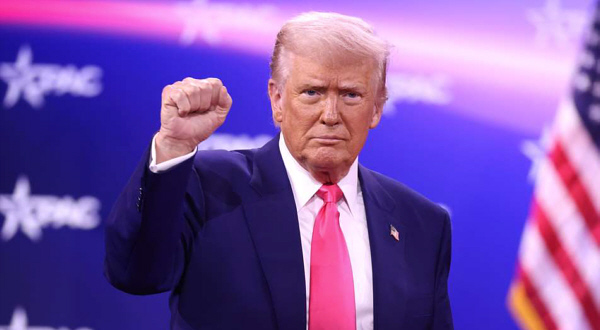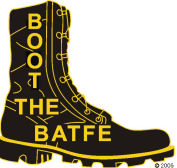

7 Things the Trump Administration Has
Done for Our Second Amendment Freedom

(Gage Skidmore via Flickr)
By Susanne Edward. April 12, 2025
Article Source
In the first months of President Donald J. Trump's (R) historic second term, his administration has wasted no time reaffirming its commitment to protecting and expanding Second Amendment rights across the country. From high-profile executive orders to targeted legal reviews, President Trump is making it clear that law-abiding Americans must be empowered to exercise their God-given and constitutionally protected right to keep and bear arms.
Most recently, the Trump administration initiated a series of actions to reinforce Second Amendment rights and reduce federal oversight on firearms.
1. A Review of All of Biden's Action
On February 7, President Trump signed an executive order directing the attorney general to review all Biden-era firearms regulations, with the goal of identifying and eliminating any rule infringing upon the constitutional rights of gun owners.
"The Second Amendment is an indispensable safeguard of security and liberty. It has preserved the right of the American people to protect ourselves, our families, and our freedoms since the founding of our great Nation," stated President Trump. "Because it is foundational to maintaining all other rights held by Americans, the right to keep and bear arms must not be infringed."
2. An End to the ATF's "Zero-Tolerance" Policy
On April 7, the DOJ announced an end to the Bureau of Alcohol, Tobacco, Firearms and Explosives' (ATF) "zero-tolerance" policy for Federal Firearms Licensees (such as gun stores). The ATF says that "the Enhanced Regulatory Enforcement Policy, aka the Zero Tolerance Policy, was repealed, "and Industry Operations inspections will no longer be held to these previously set guidelines. This page has been removed to comply with this new policy change."
3. Terminating the White House Office of Gun Violence Prevention
Early in his second term, President Trump dissolved the White House Office of Gun Violence Prevention and directed the U.S. Justice Department (DOJ) to review firearm regulations to ensure they align with a broad interpretation of gun rights.
4. HHS and Guns
The U.S. Department of Health and Human Services (HHS) removed advisories that previously treated guns as a public-health issue. This Biden administration policy had declared that "gun violence" is a public-health crisis, as if gun ownership is a virus that HHS needs to treat like a pandemic. After an executive order from President Trump, HHS removed this page from its website—specifically, this was known as the "firearm violence in America" webpage.
5. Bringing More Freedom to D.C.
On March 27, President Trump signed a wide-ranging executive order titled "Making the District of Columbia Safe and Beautiful." The order aims to restore public safety and order in the nation's capital and reaffirms Americans' right to protect themselves through lawful firearm possession and concealed carry.
In what many call a landmark move, the order created a D.C. Safe and Beautiful Task Force to coordinate efforts between federal and local authorities. Among its many responsibilities, the task force is charged with "collaborating with appropriate local government entities to provide assistance to increase the speed and lower the cost of processing concealed carry license requests in the District of Columbia."
The Trump administration's order clearly signals that the Second Amendment cannot be treated as a second-class right—not even in the federal enclave of D.C.
6. Challenging Local Licensing Bureaus
The DOJ recently launched an investigation into Los Angeles County's concealed-carry licensing procedures, probing whether law-abiding Californians are being systematically denied their rights through excessive bureaucracy and red tape. This aligns with the spirit of the U.S. Supreme Court's 2022 decision in New York State Rifle & Pistol Association v. Bruen, which struck down New York's discretionary permit regime and affirmed that the right to bear arms extends beyond the home.
Justice Clarence Thomas, writing for the majority in Bruen, cautioned that even "shall-issue" regimes could become unconstitutional if processing delays or exorbitant fees effectively deny citizens their rights.
7. Trump is Even Touching Hollywood
On April 4, in a highly symbolic move, the DOJ restored actor Mel Gibson's gun rights, which had been revoked in 2011. Several other individuals also had their rights restored.
In January, the Trump administration named Gibson, along with actors Sylvester Stallone and Jon Voight, as special ambassadors to Hollywood.
While criticized by some in the legacy media, in a sign that things may be changing with the Washington Post—a news outlet one could previously count on to take an anti-Second Amendment position when discussing firearms—that paper discussed the restoration of the right to arms with more accuracy than one would expect. The decision by DOJ underscores the administration's broader philosophy: If someone has served their sentence and paid their debt and are no longer a threat to themselves or others, then their constitutional rights, including their right to keep and bear arms, should be restored.
These actions reveal a comprehensive and proactive strategy to defend the Second Amendment—not just in theory, but in practice. From the corridors of D.C. to the streets of Los Angeles, the Trump administration is signaling that our Second Amendment-protected rights are not privileges to be doled out by bureaucrats but that this right is fundamental to our liberty.
![]()
























